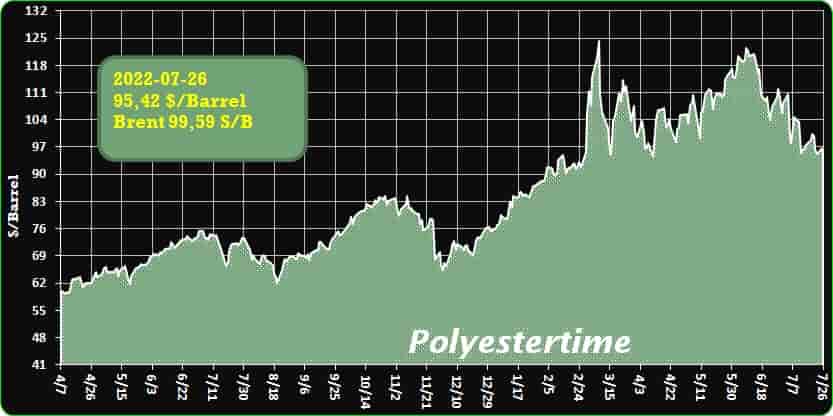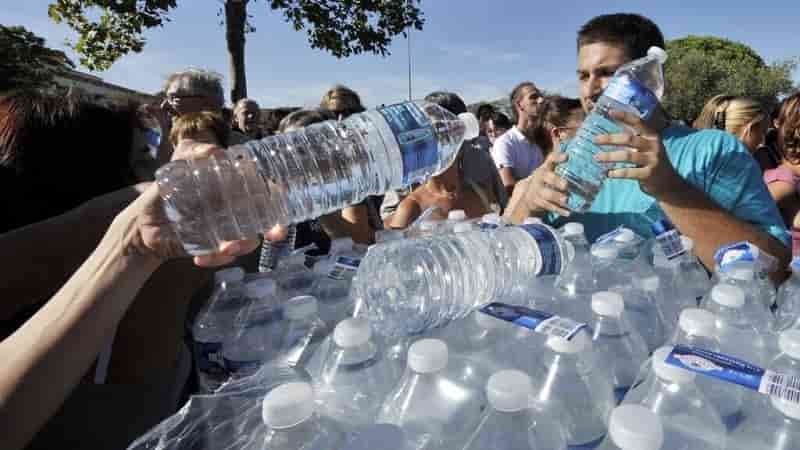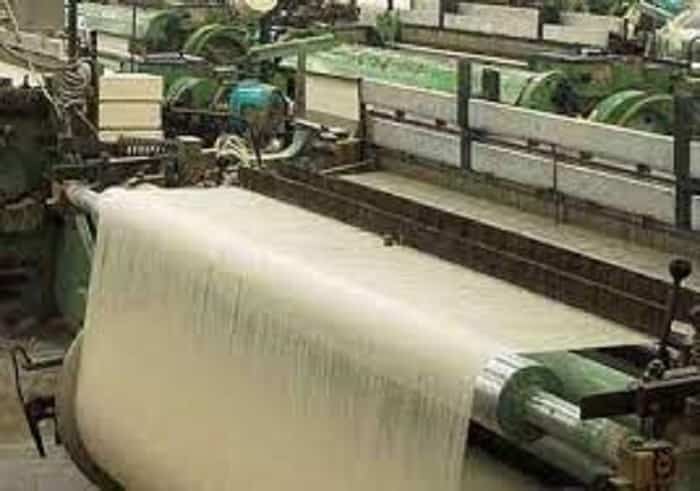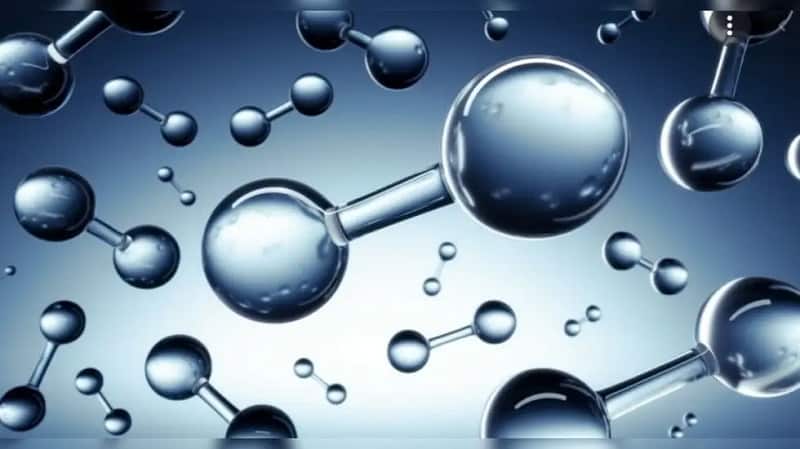Bioplastics -Green-hydrogen – RPET 26-07-2022 - Arhive
Bioplastics -Green-hydrogen – RPET
Crude Oil Prices Trend

-Bioplastics, where is the market heading?
The global bioplastics industry aims to supply 2% of the world’s demand for plastic raw materials by 2026. Regulations, certifications and adequate buyer education are essential for these materials to reach their full potential.
The urgency that society is placing on our industry to move towards more sustainable solutions has driven the development of a particular type of materials, called bioplastics. In this type of materials, we seek to migrate towards renewable sources, we seek biodegradability, or both. We have been working to develop materials that reduce our dependence on petroleum, but that can also be composted or biodegraded, in order to close the cycle.
Bioplastics, by definition, are materials that can be based on renewable or non-renewable sources, and may or may not be biodegradable. It is possible, for example, to have bio-based materials, such as bio-PE, that are not biodegradable. It is also possible to have materials based on non-renewable sources, such as BASF’s Ecovio grade, which is, however, compostable. And it is also possible to have materials such as PLA, which is bio-based and biodegradable.Bioplastics -Green-hydrogen – RPET
However, the eagerness of consumers to migrate to more sustainable solutions and the inappropriate use by some suppliers of bioplastics have led our society to believe that the materials are going to be a “silver bullet” against pollution. And this is a mistake. Bioplastics are certainly a valuable material in the circular economy, but they are not the solution to pollution problems. And it is wrong to make customers think that, by making packaging from bioplastics, we will automatically solve pollution problems.
Bioplastics have their niche market, they offer some benefits, and under proper composting conditions they can biodegrade. However, it is wrong to fall into “I am corn and not plastic” statements, as we see in some commercials. These materials are still plastics and their degradation, which may or may not occur, depends on very specific conditions and their end-of-life destination.
The correct use of this type of materials depends on having adequate access to information, avoiding “greenwashing” and achieving adequate regulation, as well as having systems for end-of-life use (such as industrial composting units) that guarantee the promise that these materials will be reintegrated into nature.
Current status and prospects
Currently, bioplastics still account for less than 1% of the more than 367 million tons of plastics produced annually. However, unlike plastics from non-renewable sources, the demand for and production of bioplastics continues to grow. This growth is driven by an increase in demand, combined with the evolution of increasingly sophisticated applications and products.Bioplastics -Green-hydrogen – RPET
According to market data compiled by EuropeanBioplastics in cooperation with the nova-Institute, global bioplastics production capacity will increase from 2.42 million tons in 2021 to around 7.59 million tons in 2026. In this scenario, the 2% mark would be exceeded for the first time. PBAT, PBS and bio-based polyamides are the materials responsible for this spectacular growth.
Currently, biodegradable plastics as a whole, including PLA, PHA, starch blends and others, account for more than 64% (over 1.5 million tons) of global bioplastics production capacity. Production of biodegradable plastics is expected to increase to almost 5.3 million by 2026 due to strong development of polymers, such as PBAT (polybutylene adipate terephthalate) and PBS (polybutylene succinate), but also steady growth of polylactic acids (PLA).

-From sustainability to circularity, what’s the difference?
The excessive consumption connected to throwaway culture and disposable fashion is no longer in vogue, as consumers increasingly look for brands and companies that care about more than just profits. With awareness surrounding overproduction and textile waste negatively impacting the environment, more brands and companies are taking a closer look at their business models and implementing sustainability strategies.
From investing in fibre alternatives to upcycling and cutting down on plastic usage, there are countless different ways textile manufacturers and brands are actively working to be more sustainable.Bioplastics -Green-hydrogen – RPET
But another concept has been gaining traction that tackles the industry’s issues with overproduction and is sustainable at its core – circularity.
Based on three principles driven by design, circularity focuses on reusing materials taken from the planet to produce textiles and garments to make new products, thereby eliminating waste and pollution. Regenerative by nature, circularity is supported by a shift to renewable energy and materials. A circular model which moves away from the linear process of production that most textile and garment companies follow, circularity is a system of frameworks that tackles current environmental issues like climate change, pollution, waste and loss of biodiversity. While some may think of sustainability and circularity as two very different concepts, the two are not as different as one may think. New legislation and proposals driving circularity are being introduced in Europe to help bring around sustainable change in the textile and garment industry.
In 2020 the UN Economic Commission for Europe (UNECE) launched the traceability initiative to accelerate the industry’s shift to more sustainable and circular business models. Bioplastics -Green-hydrogen – RPET
A year later, the UNECE introduced ‘the Sustainability Pledge’, a toolkit for measuring the environmental impact of businesses and in March of this year, the European Commission launched the EU Strategy for sustainable and circular textiles. Devised to help create a greener textile industry, the strategy implements the commitments of the European Green Deal, which sees Europe striving to become the first climate-neutral continent by transitioning to a circular economy.

-Majority of French bottled water brands contaminated by microplastics
A French study published this week shows that 78 percent of bottled mineral water analysed contains microplastics. The organisation Agir pour l’environnement is calling for a ban on plastic bottles within five years.
The results of a study called “We drink plastic” (Nous buvons du plastique) released on Thursday by Agir pour l’environnement show that, of nine bottles of mineral water analysed, seven were found to contain microplastics.
The best-selling bottled waters in France were analysed by the Breton public laboratory Labocea. The particles found include polyethylene terephthalates (used in plastic bottles) and polyethylene (used in the bottle caps).Bioplastics -Green-hydrogen – RPET
These microplastics are particles smaller than 5 millimetres and were generally found in small quantities. Worringly, the water specifically marketed “for children” (Vittel kids) had a concentration twenty times higher than the others.
“The contamination comes from the packaging, whether it’s the bottle, the cap or the lid,” explains Magali Ringoot from the association Agir pour l’environnement. Plastic has no place in bottled water. Additives are subject to industrial secrecy so we don’t know exactly what chemical cocktail we are exposed to.”
Indeed, the plastic in the cap or bottle can break up into micro debris and spread in the water. When subjected to intense heat and light, the containers could release even greater quantities of microplastics.
According to Nathalie Gontard, a packaging specialist at the French National Research Institute for Agriculture, Food and the Environment (Inrae), “plastic degrades inexorably and it starts to break down even before we start consuming the water.”
In France, 83 percent of people consume bottled water. In 2019, they consumed 133 litres of bottled water per capita, 8.9 billion litres for the entire French population.
On average, people ingest five grams of plastic every week, equivalent to “the weight of a credit card”, through the water they drink and various food products.
Widespread contamination of water
In March 2018, the publication of an American study caused a stir: for the first time, the systematic and worldwide contamination of bottled water by microplastics was brought to light. Microplastics were detected in 93 percent of the 250 bottles analysed from 11 brands in 9 different countries.Bioplastics -Green-hydrogen – RPET

-4th International Conference on Biopolymers and Bioplastics
Coalesce Research group invites you to attend the “4th International Conference on Biopolymers and Bioplastics” going to be held on November 14-15, 2022 at Rome, Italy and our main theme of the conference is “Bioworld Innovation : Environmentally, Smart, Green and Sustainable Biopolymers-Bioplastics”.
Biopolymers and Bioplastics 2022 is an attempt to explore the various ways to utilize natural resources for betterment of the future, promising a better tomorrow for the progeny and a better vision for the springing research. Bioplastics and Biopolymers conferences is anticipated to be one the best scientific conferences in Rome. The scientific sessions of this International Conference on Biopolymers and Bioplastics conferences has been designed on various related topics such as Biodegradable Polymers, Biomaterials, Nanopolymers, Thermal plastics, Plastic Pollution.Bioplastics -Green-hydrogen – RPET
Biopolymers and Bioplastics 2022 is an conference delivering an on-going concept of biobased world across the globe. In the present world, where we use the consequences of plastic products, conventional plastics, and the waste management of these products when they become waste, is a current and pressing issue all over the world. Concerns focus on the potential impact of conventional plastics they cause to the environment and how to recycle them.

-How technology boosts textile looms productivity
Maslow’s hierarchy of needs describes food, shelter, and clothing in “Physiological Needs” (lowest level at hierarchy). Textile is a perishable item which means that billions of people are going to ask for textiles multiple times in a year creating a massive demand for the product. The accumulated number of people in the world is around 7.8 billion. Estimated global demand for textiles is 1 trillion USD in 2022 with the growth rate of 4%.
This study deals with how Industrial revolution in 18th century changed textile manufacturing industry once and for all. Two basic methods to manufacture a textile are knitting and weaving. Increased market demand of textiles put industry owners under severe pressure. For this very process, new technology was installed to replace the conventional methods to manufacture textile. Textile firms who abstained from new technology have to downsize their flow of operations and workers who refrained to learn about modern technology either became un-employed or crafted a value-added fabric which held socio-cultural value to earn profits.Bioplastics -Green-hydrogen – RPET
Adoption of new technology demanded massive capital inputs for new machinery and training of workers. Workers showed a hesitation to break status-quo and labour unions have demanded higher wages and functional flexibilities to do the job. Textile firms who were successful in this transition enjoyed maximum production and earned from economies of scale, hence increasing productivity.
In the 18th century, industrial scale manufacturing of textile started in New England. Textile industry saw exponential growth and grew to multiple countries across the globe. In 1783, first cotton-spinning machine was invented by Richard Arkwright. Industrial manufacturing of fabric is done by installing manmade or synthetic fibres into manual or shuttle-less looms. The need of hour was to maximize production while using minimum recourses available. Basic raw materials used in the manufacturing of fabrics are cotton, electric supply, and labour along with machinery. Industrial Revolution played a vital role in increasing the production of textile with less human effort.
Jeremy, D. J. (1973) states that “Generally, market pressures compelled the large-scale production of cheap, standardized, low-quality goods, at first. Attempts to compete against British imports, as in the woolen industry, brought failure. Only when technological innovation supplied versatile equipment (like the cotton roving frame differential or the fancy loom dobby) for manufacturing cheap and medium-to-fine goods, could British products be challenged.” These technological advancements acted as a blessing in disguise for the American economy and achieved efficiency in flow of operations.
Multiple processes are involved to manufacture a fabric from natural or synthetic fibres. Fibres are converted into yarn through spinning process and this yard is then used to formulate a fabric through weaving or knitting. A lot of labour is required for harvesting, carding, drawing, spinning, and warping of fibres. These processes (when done manually) cost a huge number to the industrialists. However, automatic machinery for plucking, doffing, and piecing resulted in up to 400 percent increase in output due to capital saving in labour. Bioplastics -Green-hydrogen – RPET
Khanna, S. (1989) mentioned that “Rising capital intensity per unit of output implies that the modern technologies will be introduced only if the higher capital costs are offset by the savings in the wages, power and lower wastage of raw material. Sharply rising economy wide productivity and wage rates in the advanced capitalist countries has obviously made it economically worthwhile for textile firms to introduce these new technologies.”

-Northern Germany has largest green hydrogen production potential – research ministry
Rural districts in Northern Germany have the country’s largest potential for green hydrogen production due to their windpower capacities, according to a “Hydrogen Atlas” presented by the research ministry. “We want to accelerate processes and support municipalities in checking whether projects to develop a hydrogen economy in their region are actually worthwhile,” said minister Bettina Stark-Watzinger of the Atlas’s aim. Among the country’s federal states, Lower Saxony comes out on top, followed by Bavaria and Saxony-Anhalt. But it remains unclear which states will actually be in a position to fulfil their potential, project head Michael Sterner, from the technical university in Regensburg, told the energy and climate newsletter Tagesspiegel Background. “Bavaria has considerably delayed the energy transition by putting the brakes on the expansion of grids and wind power. This is now costing the high-tech state industrial sites,” he said, pointing to a lack of cheap electricity from renewable sources.Bioplastics -Green-hydrogen – RPET
Sterner added that Germany will require large amounts of green hydrogen to meet its target of becoming climate-neutral by 2045. “The demand is huge and amounts to 600 to 700 TWh, which is about three times the volume of all gas storage facilities,” he said. “Hydrogen is thus by no means the champagne of the energy transition, but along with renewable electricity, [it is] the main fuel for making Germany climate-neutral.
” Stark-Watzinger said Germany will always remain an importer of green hydrogen as it can be produced at lower cost in locations with higher renewable potential, such as Australia, Africa, and South America. But the country must press ahead with domestic production if it is to fulfil the government’s ambition of making hydrogen technologies an export success, she said. Bioplastics -Green-hydrogen – RPET

-NCTO: China Penalty Tariffs on finished textiles and apparel to be maintained
China Penalty Tariffs on Finished Textiles & Apparel Give U.S. Companies a Chance to Compete and are a Powerful Trade-Negotiation Tool, NCTO Tells U.S. International Trade Commission Bioplastics -Green-hydrogen – RPET
Section 301 penalty tariffs on finished Chinese textile and apparel imports give American manufacturers a chance to compete and provide trade officials with an essential trade negotiation tool, the National Council of Textile Organizations (NCTO) told a key government panel today in a formal written submission. Removing them, the association said, would reward China, put U.S. manufacturers at a competitive disadvantage and do nothing to reduce inflation.
Those were among the key points outlined by NCTO President and CEO Kim Glas in a written testimony submitted to the U.S. International Trade Commission during three days of hearings on the economic impact of Section 301 China tariffs and Section 232 steel tariffs on U.S. industries.
The 301 penalty tariffs should be maintained “absent substantive improvements in China’s pervasive, predatory trade practices,” Glas said in her testimony. China’s illegal actions “have put U.S. companies at a serious disadvantage, and tariffs give American manufacturers a chance to compete.” Glas noted that U.S. trade officials have “stressed that the penalty tariffs also create leverage and are a ‘significant tool’ in ongoing negotiations with China.”
While some advocates for lifting the tariffs point to concerns about inflation, Glas said, “canceling these penalty duties would do little to ease Americans’ inflationary pains.” She also noted that “apparel prices out of China continue to hit rock bottom even with the Section 301 tariffs in place. As detailed in an economic study recently released by Werner International, U.S. import prices for apparel from China have dropped 25 percent since 2019 and 50 percent since 2011.” Bioplastics -Green-hydrogen – RPET

-Chemical Conversations: Sustainability in the European chemical industry
Argus is pleased to collaborate with the European Petrochemical Association (EPCA).
Argus SVP Strategy and Business Development Muhamad Fadhil speaks to Hartwig Michels, President of BASF’s Petrochemicals Division and EPCA President, Gina Fyffe, CEO of Integra and Chair of the EPCA’s talent, diversity and inclusion committee and James Elliott, Argus European Business Development Manager.
In this wide-ranging roundtable, Fadhil, Hartwig, Gina and James speak about sustainability in the European chemical industry against the backdrop of a more challenging economic environment.Bioplastics -Green-hydrogen – RPET
Muhamad Fadhil: Hello everyone and welcome to “Global Chemical Conversations.” My name is Muhamad Fadhil, and I’m the SVP Strategy and Business Development at Argus. This is a very special episode jointly brought to you by Argus Media, a leading independent provider of energy and commodity pricing information and the European Petrochemical Association or EPCA in short.
In this episode, we have two very special industry guests, Hartwig Michels, president of BASF’s petrochemical division and president of the EPCA, and Gina Fyffe, CEO of Integra and chair of the EPCA’s Talent, Diversity and Inclusion Committee. I’m also joined by my colleague James Elliott, European Business Development Manager at Argus.
Hello everyone. Thank you for joining me today. James, firstly, can you set the scene? What’s driving sustainability in the European petrochemical industry?
James Elliott: Thanks Fadhil, it’s great to be here with you today. The drive to sustainability in Europe is multi-layered. Firstly, you have regulation. For instance, the European Green Deal which set the EU on a course to become a sustainable, climate-neutral, and circular economy by 2050. This is written into European climate law, which also sets the intermediate target of reducing net greenhouse gas emissions by at least 55% by 2030 compared to 1990 levels. We have to consider the consumer too. We, the consumer, society, have become aware of the need for sustainable solutions. We’re demanding goods made from sustainable sources and recycled material and companies are reacting to this. Brand owners are making new pledges on a regular basis about selling their goods using recycled and recyclable packaging. The financial community needs to be highlighted too. With ESG investing, the chemical industry needs to be focused on sustainability in order to attract investment.Bioplastics -Green-hydrogen – RPET
There is the business side too – cost is such an important driver. And that applies to sustainability. Why use virgin material if recycle material can fulfill the same role at a lower cost? European chemical companies have either aligned their sustainability goals with the UN Sustainable Development Goals, or with the European Green Deal, or perhaps they have stated further ambitions within their goals. The European chemical industry is now working and investing to achieve their sustainability goals.
Muhamad Fadhil: Well said, James. Hartwig, BASF is a global chemical producer. How does BASF assess where to focus sustainability initiatives or investments? Is it by value chain, product, or geography?
Hartwig Michels: Well, Fadhil, thank you very much for having me here. To your question, as a global player that has pledged to achieve climate neutrality by 2050, we at BASF are driving our emission reductions and our push for circular economy, of course, in all regions already today. And since the vast majority of our CO2 emissions is originating from the production of base chemicals and from the production of power as steam, this is where we put specific emphasis, it’s basic chemicals and it’s energy. So let me give you one example here. We are investigating, for instance, several options to substitute the fossil fuel used to generate the heat in the steam cracker furnaces. This can be done either by the use of climate-friendly fuels, such as biomethane or hydrogen or via electrification of the furnaces in combination with the use of renewable energy. And we are also looking into the option to directly capture the CO2 emitted from the furnaces and storing it permanently. Later this year, we will have the groundbreaking for the world’s first pilot electric cracker furnace. We are pursuing this project, for instance, jointly with our partner, SABIC, and Linde.Bioplastics -Green-hydrogen – RPET

Bioplastics -Green-hydrogen – RPET
